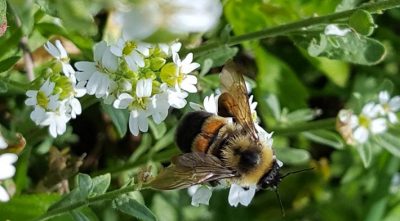Lawsuit Challenges Trump EPA’s 200 Million-acre Expansion of Bee-killing Pesticide

The Center for Biological Diversity and Center for Food Safety sued the Trump administration today over its July decision to approve use of the bee-killing pesticide sulfoxaflor across more than 200 million acres of crops.
The approval was granted despite the fact that the Environmental Protection Agency’s own scientists concluded that sulfoxaflor is “very highly toxic” to bees. The decision expands the pesticide’s use to a wide range of crops that attract bees, including soybeans, cotton, strawberries, squash and citrus.
“Even for Trump’s EPA, which seems to measure success by pesticide-company profits, it’s stupefying to OK spraying a bee-killing poison across millions of acres of crops frequented by bees,” said Lori Ann Burd, director of the Center for Biological Diversity’s environmental health program. “While leading scientists and countries across the globe are calling for eliminating harmful bee-killing pesticides like sulfoxaflor, Team Trump is cheerfully promoting its use like a corporate PR firm. It’s nauseating.”
Today’s lawsuit, filed in the 9th Circuit Court of Appeals, contends that before approving the sweeping new uses of sulfoxaflor, the EPA failed in its legal duty to compile “substantial evidence” required under theFederal Insecticide, Fungicide, and Rodenticide Act. FIFRA, as it’s known, is the federal law underpinning the U.S. system of pesticide regulation, designed to protect applicators, consumers and the environment.
The EPA also violated its duty to ensure that its approval of sulfoxaflor doesn’t jeopardize the continued existence of endangered species by consulting on the effects of its actions with wildlife experts at the U.S. Fish and Wildlife Service and National Marine Fisheries Service.
In addition to imperiling bees and butterflies, the EPA’s broad approval for sulfoxaflor also likely threatens endangered plants that rely on insect pollination.
Under the new approval, sulfoxaflor can be used on alfalfa, cacao, corn, cotton, grains, pineapple, sorghum, soybeans and strawberries as well as on tree plantations, ornamental crops and citrus orchards.
“This decision was pure pro-pesticide politics,” said George Kimbrell, legal director of the Center for Food Safety. “Trump’s EPA can’t justify throwing our already imperiled pollinators under the bus. That’s why the agency offered no chance for the public to comment. And that’s why we’re suing them.”
To achieve its goal of approving sulfoxaflor, the Trump EPA rejected the findings of a highly relevant study published in the scientific journal Nature — the world’s gold standard for peer-reviewed journals — that found even low doses of sulfoxaflor exposure had severe consequences for bumblebee reproductive success.
Instead the EPA chose to accept only the findings of a confidential, non-peer-reviewed Dow Chemical study that concluded sulfoxaflor is less harmful to bumblebees. But even the Dow study found that the level of sulfoxaflor considered safe for bumblebees to consume is five times lower than the dose the EPA had identified as safe for honeybees.
Independent studies have shown that honeybees are less susceptible to the effects of pesticides than other pollinators, especially native solitary bees, due to the resilience provided by living in highly structured hives. Yet the EPA failed to even consider the pesticide’s impacts on the nation’s more than 4,000 species of native bees.
The EPA ultimately concluded that the dose of sulfoxaflor considered safe for honeybees is safe for all insects.
At the request of industry, the EPA waived the legal requirement for a full-field study of the pesticide’s impacts on pollinators, saying it would “not add meaningful input to our conclusions,” indicating that the approval was a foregone conclusion.
The EPA also weakened the few restrictions in place on spraying sulfoxaflor designed to protect native pollinators and other wildlife, eliminating all requirements for buffers even during aerial spraying.
And the EPA approved spraying of crops with sulfoxaflor just before — or even during — bloom, exposing pollinators to a pesticide the agency knows harms them.
*
Note to readers: please click the share buttons above or below. Forward this article to your email lists. Crosspost on your blog site, internet forums. etc.
Featured image: Rusty patched bumble bee, Eau Claire, by Tamara Smith/USFWS available for media use with appropriate credit. Image is available for media use.

